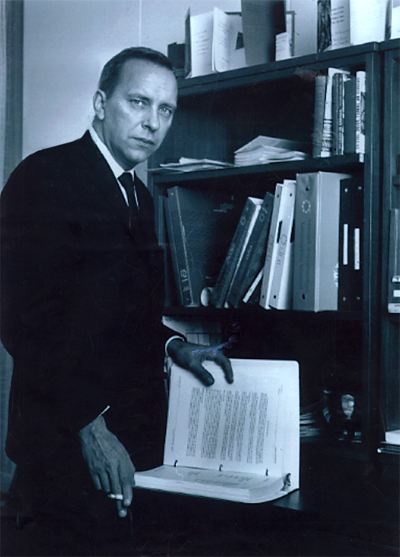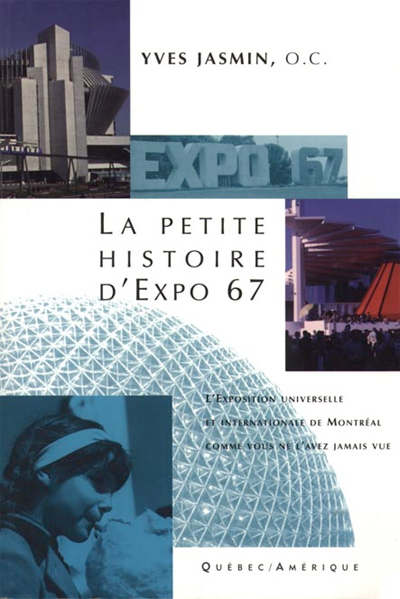Located on Île Notre-Dame, the Arab Pavilion Complex featured the pavilions of The United Arab Republic (Egypt), Algeria, and Kuwait.
The United Arab Republic (Egypt) Pavilion
 The exterior of the United Arab Republic (UAR) pavilion featured intricate arcades typical of Moorish architecture. There were gardens around the pavilion and near the entrance was a panel of 5 sculptured figures. They represented the landmarks of Egypt's development from the time of the Pharaos, through Roman, Christian and Islamic eras, and finally, to the then-recent establishment of a republic.
The exterior of the United Arab Republic (UAR) pavilion featured intricate arcades typical of Moorish architecture. There were gardens around the pavilion and near the entrance was a panel of 5 sculptured figures. They represented the landmarks of Egypt's development from the time of the Pharaos, through Roman, Christian and Islamic eras, and finally, to the then-recent establishment of a republic.
Inside the pavilion, a beautiful replica of the mythical mask of Tutankhamen was on display, along with replicas of furniture found in the young Pharao's tomb upon it's legendary discovery in 1923.
 A sector of the pavilion focussed on the industries of iron and steel, explaining their key role in the modernization of Egypt. Photographs and maps documented large-scale projects such as The Helwan steel complex and the Aswan dam, as well as the 703 factories established between 1952 and 1964. Hundreds of industrial products were displayed to illustrate the UAR's economy: heavy machinery, motors, firearms, television sets, etc.
A sector of the pavilion focussed on the industries of iron and steel, explaining their key role in the modernization of Egypt. Photographs and maps documented large-scale projects such as The Helwan steel complex and the Aswan dam, as well as the 703 factories established between 1952 and 1964. Hundreds of industrial products were displayed to illustrate the UAR's economy: heavy machinery, motors, firearms, television sets, etc.
Another sector of the pavilion compared and contrasted ancient and modern Egypt in fields such as housing, education and handicrafts.

The Pavilion of Algeria
Next to the pavilion of Egypt was that of Algeria, bearing an almost identical architectual style: traditional yet tranquil.
 In the main hall of the pavilion, the visitor was acquainted with both ancient and current aspects of Algerian history. On 12 screens, films and color slides highlighted Algerian architectual digs, the crusade against illiteracy, important mineral resources, the expansion of the petroleum industries, and developments in agriculture and technology.
In the main hall of the pavilion, the visitor was acquainted with both ancient and current aspects of Algerian history. On 12 screens, films and color slides highlighted Algerian architectual digs, the crusade against illiteracy, important mineral resources, the expansion of the petroleum industries, and developments in agriculture and technology.
A display of beautiful art objects illustrated Algeria's most ancient history up to the modern day (1967). One showcase featured a skull that proved that human life existed in Algeria 300 000 years prior. Ancient relics and maps revealed that relations between Algeria and Egypt existed as far back as 5000 B.C.
Tools, urns, necklaces, bronze statuettes and perfume vases illustrated a laical Oriental tradition influenced by Greece and Rome. Photographs and moldings of beautiful ancient ruins recalled the days of Roman Algeria, and the subsequent rebellion against Rome's supremacy.
Another section showed life in Muslim Algeria during the 17th and 18th centuries. Intricate muscial instruments dating from that period were on display. The accoutrements of legendary Algerian horsemen were also shown: pistols, swords and scabbards, finely engraved with silver and inlayed with gems.
 Typical Algerian fare could be sampled in the pavilion's restaurant: couscous, heady Algerian wine, fine pastries flavored with honey, etc.
Typical Algerian fare could be sampled in the pavilion's restaurant: couscous, heady Algerian wine, fine pastries flavored with honey, etc.
The Kuwait Pavilion
 The Kuwait pavilion featured the same Moorish style of architecture as it's neighbors. The theme of the Kowait pavilion revolved around oil, and the benefits it had brought to the country.
The Kuwait pavilion featured the same Moorish style of architecture as it's neighbors. The theme of the Kowait pavilion revolved around oil, and the benefits it had brought to the country.
The impact of oil bestowed on the population of Kuwait the highest per capita income in the world (in 1967). Kuwait was experienced an economic boom: highways were being built to service new industries such as the production of chemicals or electricity. Kuwait's new prosperity contrasted with it's previous desert existence.
The Kuwait pavilion received as many as 5000 Expo visitors a day. Then, on the morning of May 29, 1967, as a result of Middle Eastern tension, the pavilion locked it's doors. The exhibits were removed 2 weeks later, making Kuwait the only country to leave Expo 67 before it's closing.
images: (1-2) westland.net/expo67
(3) FOS productions
(4-5-6) library and archives Canada
The United Arab Republic (Egypt) Pavilion
 The exterior of the United Arab Republic (UAR) pavilion featured intricate arcades typical of Moorish architecture. There were gardens around the pavilion and near the entrance was a panel of 5 sculptured figures. They represented the landmarks of Egypt's development from the time of the Pharaos, through Roman, Christian and Islamic eras, and finally, to the then-recent establishment of a republic.
The exterior of the United Arab Republic (UAR) pavilion featured intricate arcades typical of Moorish architecture. There were gardens around the pavilion and near the entrance was a panel of 5 sculptured figures. They represented the landmarks of Egypt's development from the time of the Pharaos, through Roman, Christian and Islamic eras, and finally, to the then-recent establishment of a republic.Inside the pavilion, a beautiful replica of the mythical mask of Tutankhamen was on display, along with replicas of furniture found in the young Pharao's tomb upon it's legendary discovery in 1923.
 A sector of the pavilion focussed on the industries of iron and steel, explaining their key role in the modernization of Egypt. Photographs and maps documented large-scale projects such as The Helwan steel complex and the Aswan dam, as well as the 703 factories established between 1952 and 1964. Hundreds of industrial products were displayed to illustrate the UAR's economy: heavy machinery, motors, firearms, television sets, etc.
A sector of the pavilion focussed on the industries of iron and steel, explaining their key role in the modernization of Egypt. Photographs and maps documented large-scale projects such as The Helwan steel complex and the Aswan dam, as well as the 703 factories established between 1952 and 1964. Hundreds of industrial products were displayed to illustrate the UAR's economy: heavy machinery, motors, firearms, television sets, etc.Another sector of the pavilion compared and contrasted ancient and modern Egypt in fields such as housing, education and handicrafts.

The Pavilion of Algeria
Next to the pavilion of Egypt was that of Algeria, bearing an almost identical architectual style: traditional yet tranquil.
 In the main hall of the pavilion, the visitor was acquainted with both ancient and current aspects of Algerian history. On 12 screens, films and color slides highlighted Algerian architectual digs, the crusade against illiteracy, important mineral resources, the expansion of the petroleum industries, and developments in agriculture and technology.
In the main hall of the pavilion, the visitor was acquainted with both ancient and current aspects of Algerian history. On 12 screens, films and color slides highlighted Algerian architectual digs, the crusade against illiteracy, important mineral resources, the expansion of the petroleum industries, and developments in agriculture and technology.A display of beautiful art objects illustrated Algeria's most ancient history up to the modern day (1967). One showcase featured a skull that proved that human life existed in Algeria 300 000 years prior. Ancient relics and maps revealed that relations between Algeria and Egypt existed as far back as 5000 B.C.
Tools, urns, necklaces, bronze statuettes and perfume vases illustrated a laical Oriental tradition influenced by Greece and Rome. Photographs and moldings of beautiful ancient ruins recalled the days of Roman Algeria, and the subsequent rebellion against Rome's supremacy.
Another section showed life in Muslim Algeria during the 17th and 18th centuries. Intricate muscial instruments dating from that period were on display. The accoutrements of legendary Algerian horsemen were also shown: pistols, swords and scabbards, finely engraved with silver and inlayed with gems.
 Typical Algerian fare could be sampled in the pavilion's restaurant: couscous, heady Algerian wine, fine pastries flavored with honey, etc.
Typical Algerian fare could be sampled in the pavilion's restaurant: couscous, heady Algerian wine, fine pastries flavored with honey, etc.The Kuwait Pavilion
 The Kuwait pavilion featured the same Moorish style of architecture as it's neighbors. The theme of the Kowait pavilion revolved around oil, and the benefits it had brought to the country.
The Kuwait pavilion featured the same Moorish style of architecture as it's neighbors. The theme of the Kowait pavilion revolved around oil, and the benefits it had brought to the country.The impact of oil bestowed on the population of Kuwait the highest per capita income in the world (in 1967). Kuwait was experienced an economic boom: highways were being built to service new industries such as the production of chemicals or electricity. Kuwait's new prosperity contrasted with it's previous desert existence.
The Kuwait pavilion received as many as 5000 Expo visitors a day. Then, on the morning of May 29, 1967, as a result of Middle Eastern tension, the pavilion locked it's doors. The exhibits were removed 2 weeks later, making Kuwait the only country to leave Expo 67 before it's closing.
images: (1-2) westland.net/expo67
(3) FOS productions
(4-5-6) library and archives Canada











































